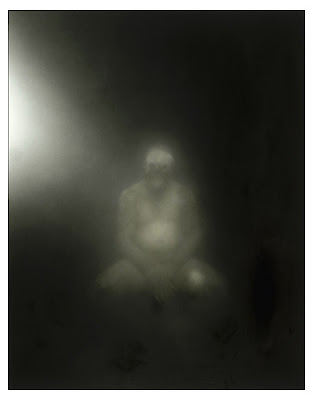
Wayne Martin Belger in his studio/workshop
Fine Art photography can be as unique and original as the artists themselves. A few can be more extreme than others, if not in technique or concept, at least in approach.
Wayne Martin Belger's approach to his work is both unique and intriguing at the same time. Instead of concentrating on technique, which most of us are concerned with, he has chosen to concentrate on the camera itself as an expression of his art. Reducing technique to its most elemental form, pinhole photography, he turns our attention to the "camera" as the very subject and object of his art -- a metaphorical prism through which we can examine his subjects and gain a deeper understanding of his personal perspective and vision.
Born in Pasadena, California to religious parents, Wayne became interested religious rites and sacred practices when he was still a boy. He became accutely facinated with the ritual tools used by the priests and holy men that enabled direct communion with the divine. Employing the same materials used in sacred rituals by priests and shamans, metals in combination with organic parts (blood, bone, organs), he builds cameras that enable him to be in direct communication with his subjects.
Wayne starts each project by studying and researching them. He then visualizes the photographs and starts collecting parts, artifacts and relics related to the subject. He then builds a camera for each of his projects. Some of the materials he has employed in his cameras are: Aluminum, Titanium, Copper, Brass, Bronze, Steel, Silver, Gold, Wood, Acrylic, Glass, Horn, Ivory, Bone, Human Bone, Human Skulls, Human Organs, Formaldehyde and HIV+ Blood.
As a photographer and camera collector, I am naturally drawn to Wayne's art -- it inspires me and gives me ideas for my own work.
Here is a good selection of Wayne's cameras and a photograph he took with each one of them:
Warning: Wayne's subject matter and material can offend and infuriate people with delicate sensibilities. Like any good work of art, it requires an open mind, so please proceed accordingly.
HIV Camera : 4"x5" camera made from Aluminium, Copper, Titanium, Acrylic and HIV positive blood. The blood pumps through the camera, then in front of the pinhole and becomes Wayne's #25 red filter. Designed to shoot a geographic comparison of people suffering from HIV.
Third-Eye Camera : 4"x5" camera made from Aluminium, Titanium, Brass, Silver, Gem Stones and a 150 year old skull of a 13 year old girl. Light and time enters at the third eye, exposing the film in the middle of the skull. The camera was designed to study the beauty of decay.

Dragonfly Camera : 4"x5" camera made as an altar for a 9 year old girl that passed away. Made from Aluminium, Steel, Acrylic, Insects, and other relics. Used to study and photograph time segments of children.

Heart Camera : 4"x5" camera made from Aluminium, Titanium, Acrylic, Formaldehyde and an infant human heart. Designed to take photos of soon-to-be mothers who are at least 8 months pregnant, and explore Wayne's relationship with his twin brother who died at birth.


Go to Wayne Martin Belger's website, http://www.boyofblue.com/ for an update on his latest projects and for more examples of his exotic cameras.
-- Photos and camera descriptions taken from boyofblue.com. Portrait by A Franz Buhler.




















No comments:
Post a Comment